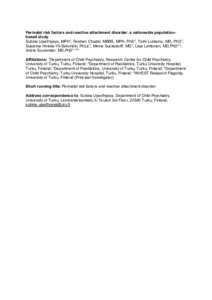Perinatal risk factors and reactive attachment disorder: a nationwide population‐based study
Sucksdorff Minna; Chudal Roshan; Sourander Andre; Upadhyaya Subina; Luntamo Terhi; Hinkka‐Yli‐Salomäki Susanna; Lehtonen Liisa
https://urn.fi/URN:NBN:fi-fe2021042826850
Tiivistelmä
Aim
To examine the association between several perinatal and obstetric risk factors and reactive attachment disorder in children diagnosed in specialized services.
Methods
In this nested case control study, 614 cases with reactive attachment disorder and 2,423 controls matched with age and sex were identified from Finnish national registers. Conditional logistic regression was used to examine the association between a number of perinatal risk factors and reactive attachment disorder.
Results
In the adjusted analysis, a low birthweight of <2,500 grams was associated with an increased odds of reactive attachment disorder, with an odds ratio (OR) of 1.96 and 95% confidence interval (CI) of 1.17, 3.30 and a birthweight of 4,000‐4,499 grams was associated with decreased odds OR 0.49 (95% CI 0.31, 0.75). The odds for being diagnosed with reactive attachment disorder increased with a gestational age of <32 weeks OR 3.72 (95% CI 1.52, 9.10), induced labour OR 1.34 (95% CI 1.03, 1.75) and monitoring in a neonatal intensive care unit (NICU) OR 1.67 (95% CI 1.09, 2.55).
Conclusion
We found associations between low birthweight, preterm birth, NICU admission and reactive attachment disorder. The findings add to the current literature on the understanding of the development of reactive attachment disorder in children.
Kokoelmat
- Rinnakkaistallenteet [19207]
